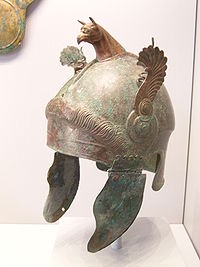
Attic helmet
Encyclopedia

Classical Greece
Classical Greece was a 200 year period in Greek culture lasting from the 5th through 4th centuries BC. This classical period had a powerful influence on the Roman Empire and greatly influenced the foundation of Western civilizations. Much of modern Western politics, artistic thought, such as...
and was widely used in Italy and the Hellenistic world until well into the Roman Empire
Roman Empire
The Roman Empire was the post-Republican period of the ancient Roman civilization, characterised by an autocratic form of government and large territorial holdings in Europe and around the Mediterranean....
.
It was similar to the Chalcidian helmet
Chalcidian helmet
A Chalcidian helmet or Chalcidian type helmet was a helmet made of bronze and worn by ancient warriors of the Hellenic world, especially popular in Greece in the fourth and fifth centuries BC...
but lacked a nose-guard. Although in Greece itself its use was not as widespread as the Corinthian
Corinthian helmet
The Corinthian helmet originated in ancient Greece and took its name from the city-state of Corinth. It was a helmet made of bronze which in its later styles covered the entire head and neck, with slits for the eyes and mouth. A large curved projection protected the nape of the neck...
or Phrygian
Phrygian type helmet
The Phrygian type helmet was a type of helmet that was originated in Classical Greece and was widely used in Thrace, Dacia, Italy and the Hellenistic world until well into the Roman Empire. It received its name due to its resemblance to the Phrygian cap....
types, the Attic helmet became very popular in Italy, where most examples have been found. As an artistic motif, it long outlasted its contemporaries, being used to impart an archaic look in the depictions of generals, emperors and Praetorians
Praetorian Guard
The Praetorian Guard was a force of bodyguards used by Roman Emperors. The title was already used during the Roman Republic for the guards of Roman generals, at least since the rise to prominence of the Scipio family around 275 BC...
(example) throughout the Hellenistic and Roman periods. As such, they have become part of the popular image of a Roman officer, as found in art from the Renaissance onwards or in earlier Hollywood productions, but it is very unlikely that they were actually used.
See also
- Illyrian helmet
- Corinthian helmetCorinthian helmetThe Corinthian helmet originated in ancient Greece and took its name from the city-state of Corinth. It was a helmet made of bronze which in its later styles covered the entire head and neck, with slits for the eyes and mouth. A large curved projection protected the nape of the neck...
- Thracian helmet
- Boeotian helmetBoeotian helmetThe Boeotian helmet was a type of helmet that was used in Classical Antiquity and the Hellenistic period and originated in Boeotia. It was an open helmet, allowing good peripheral vision and unimpaired hearing, and was therefore used primarily by the cavalry. Hence its use was not as widespread as...

